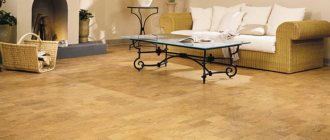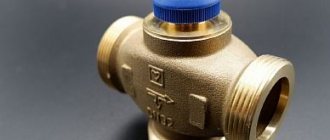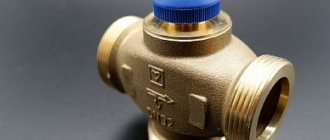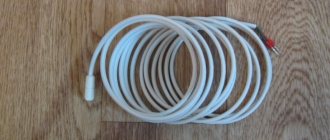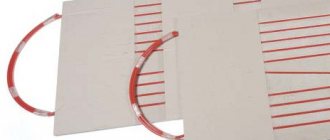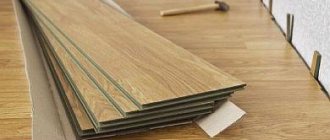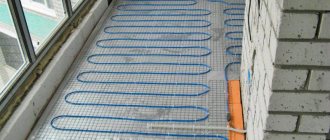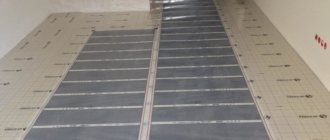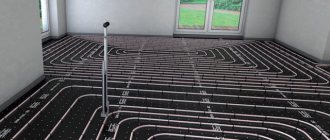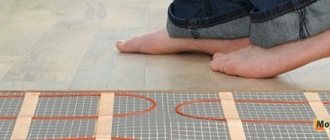When installing heated floors and most types of floor coverings, a special underlay is used, which performs a lot of functions. One of its most popular types is foil for underfloor heating. Some, trying to save on repair work, believe that they can refuse it. However, this step would be a grave mistake. An underlay must be used for installing heated floors.
Foil for heated floors
Structure of foil thermal insulation material
Most types of foil-coated thermal insulation materials are produced in rolls, which ensures ease of use during installation work.
In general, most insulation materials have a two-layer structure - base and foil. The basis can be:
- basalt;
- mineral;
- polystyrene foam;
- polyethylene.
Each of these materials is environmentally friendly, safe for health due to its inertness, and has excellent fire safety performance. Also, most types of base have a bubble structure, and air, as you know, is one of the worst conductors of heat.
The foil layer is a foil made of aluminum, the role of which is to directly reflect thermal energy. It allows the returned heat to be evenly distributed, but the base prevents it from going into the screed.
On a note! Foil insulation is mostly elastic and soft materials, so the installation process is quite simple.
Due to the fact that most thermal insulation materials with a foil layer can withstand heating up to +90 degrees, such substrates can be used for any type of underfloor heating systems. By the way, on the surface of the foil insulation there are often markings that facilitate the process of laying the cable - you don’t have to constantly fiddle with a tape measure. With this material it is also easier to install a water floor system. Another feature of some foil materials is the sticky layer. It allows you to fix the insulation in one place during installation and will not allow it to move.
Operating principles of heat transfer
You can understand whether foil insulation is needed inside a residential building by studying the basics of heat transfer and the main principles in its operation. This is a physical phenomenon that occurs through radiation or physical means.
The contact method of heat transfer is characterized by the proximity of a group of objects; through contact they strive to balance and stabilize temperatures. Two surfaces touching each other will, after some time, become of equal heat.
These statements are true in the absence of exposure to external energy sources. Otherwise, heat will be transferred from the coolant to the cold elements of the bond on an ongoing basis.
Heat transfer is inevitable, and when installing a heated floor in a house, the process becomes permanent. Radiation occurs from the hottest body into a cold environment characterized by a lower temperature.
In an air or gas environment, the coolant emits infrared radiation. IR rays do not heat the air, but only physical objects. A layer of air, for example, found in thermal insulation materials, can prevent heat transfer. A thermos works on this principle, inside of which there is a flask in double walls made of glass and a coated mirror.
Is underfloor heating insulation necessary? Do you need foil?
| Installation of heated floors follows the same recipe. The first step is to install edge insulation and lay foam. This is necessary so that the heat goes up, i.e. so that the pipes or cable heat your floor, and not heat your neighbors’ ceiling. Some installation organizations recommend laying so-called foil foam on top of the foam, i.e. polyethylene insulation covered with aluminum foil. This is argued by the fact that, firstly, foam a few millimeters thick provides additional insulation, and secondly, the foil is needed to reflect heat rays upward from its surface. Is this really so and how advisable is it to use such foil? Let's consider the first consideration: additional insulation with foam under the foil. The thickness of the main insulation - polystyrene foam or polystyrene that is laid on the floor covering, must be at least 3 cm for interfloor ceilings, and 5-8 cm for floors on the ground or above basements. An additional 1-2mm of foam under the foil will give an increase in heat transfer resistance of about 1-5%. Does it make sense to buy this kind of insulation and pay for the flooring if the insulation improves so little? No. If there is such a need, then it will be cheaper to lay thicker foam. The second argument: the foil in the screed acts as a mirror for “heat rays”, reflecting heat upward and not letting it down. As an example, thermoses are sometimes cited, where a flask with hot water is lowered inside another flask, which has a mirror coating on the inside. Substrate for heated floors purpose and types Let's consider this consideration. We'll have to remember a little physics, but we can handle it. Heat in nature can be transferred in three ways:
|
The key point necessary for the transfer of heat by radiation is this. The medium in which such heat transfer occurs must be transparent. The sun will not warm you underground (sorry for the gloomy analogy). Rays of any spectrum, incl. infrared, do not pass through concrete. There is no heat transfer by radiation inside the concrete screed. Foil cannot reflect anything inside the heated floor structure. Therefore, the foil itself inside the floor screed does not make sense.
In addition, concrete very quickly corrodes zinc, foil, and metal in general. Do an experiment. Take a piece of such insulation and spread it with a thin layer of concrete, which after a couple of days will be easy to wipe off with a rag. Look at what will be under the concrete in a couple of days. You will see that the foil is no longer there. The cement will eat up the entire reflective coating in just a few days. Therefore, none of the arguments presented in favor of using foil foam or its analogues stand up to criticism.
If our arguments seem insufficient to you, then look at another method of laying underfloor heating pipes, which is offered by almost all manufacturers of components for underfloor heating.
These are polystyrene profiled slabs with “stumps”, between which a pipe is laid. Concrete is immediately poured over such mats; there are no reflectors there, and this is considered a higher quality and professional solution than just foam plastic. Thus, you should not overpay for foil insulation when installing heated floors. Compared to the general background, its cost is not very significant, but since it is completely meaningless, it is not worth doing it. And the wide open jaw of the installers when you tell them all this will give you a lot of pleasure.
Features, types and characteristics
Connecting a heated floor to a thermostat
Thanks to the foil, this combined material reliably retains heat in the room and has a heat- and water-repellent effect. Foamed penofol, in turn, has a porous surface that perfectly retains heat and acts like a thermos. The material, although it has several layers, is thin, so when laid on the floor it does not reduce the height of the room.
It is ideal to place it on the first floors, under which there are basements, as it does not allow the cold and dampness emanating from them to pass through. Foil insulation is often used for floors with a concrete base, saunas and rooms that have a “warm floor” system.
Varieties
When purchasing such material, you need to check its heat-reflecting layer; it may have an aluminum coating or be made of foil. Some manufacturers, trying to reduce the cost of the material, spray a thin aluminum layer on its surface, so the quality of the insulation deteriorates.
Types of heat insulators differing in design and purpose:
- Foiled polystyrene foam. It is used exclusively for floor insulation. It is made in the form of steel-colored layers with great thickness. On photo-foil polystyrene foam
- Foamed polyethylene. It is most often used for insulation of ventilation and sewer systems, as well as for walls and floors. Manufactured in the form of rolled material with aluminum coating. Photo-foamed polyethylene
- Basalt foil insulation. This type is highly resistant to external influences; it is even used for gas stations. The material can withstand temperature changes ranging from -200°C to +700°C. The photo shows basalt foil insulation
- Mineral wool with foil. Sold in rolls, which are most often used for insulating roofs, pipes located on them, floors on balconies and bathhouses. The photo shows mineral wool with foil
The most popular are roll-type insulation materials made from foamed ethylene foam. Almost all of them are produced under the same brand - Penofol.
They have their own qualifications, depending on the location of the foil layer on them, there are four types:
- Type “A” is the classic variety, which has foil on only one side.
- Type “B” is a dense material with welded foil on both sides.
- Type “C” - it has foil on one side and a self-adhesive base on the other.
- Type “ALP” - comes with one foil layer, which is laminated with polyethylene.
What names of insulation with foil exist and in what area of construction they are used are described in detail in this article.
Depending on the structure of penofol, there are several grades that are suitable for laying on the floor:
- Penofol 2000 A - there is a foil layer on its outer surface. For installation in rooms with high humidity, it is necessary to install waterproofing on top of it. Its analogues with the letters “B” and “C” are reliably protected from moisture, so they do not require an additional protective layer. For photo-penofol 2000 A
- Penofol ALP - used for “warm floors” powered by electricity. After the rolled insulation is placed on top of it, a screed is performed. Its foil layer is covered with a special protective film, which makes the material resistant to damage. On photo-penofol ALP
- Penofol C is a classic version of foil insulation. On photo - penofol C
- Penofol 2000 R – the material has a smooth and embossed side, the foil is located on the latter. For photo-penofol 2000 R:
- Penofol Super NET retains heat better than other types and has a long service life. It is available in three types: A, B and C. It has good characteristics, as it has a special structure, which consists of canvases, and a polyethylene foam mesh is located between them. For photo-penofol Super NET:
- Penofol 2000 M - should be placed in several layers, since the foil layer on it is on the smooth side, and the embossed one remains open.
What thickness to choose
The optimal thickness of any substrate is 3 mm. It allows you to level out screed errors of up to 1 mm. A 2 mm cork substrate will also cope with this task, due to its high density and elasticity.
If the height of the floor screed differs by 1-2 mm, a substrate 4 mm thick will be required, 2-3 mm - 5 mm thick. For more significant floor unevenness, the problem must be solved using a self-leveling mixture.
The appearance on sale of substrates with foil is caused primarily by the appearance of heated floors. When laying laminate flooring, they allow you to better retain heat in the apartment and protect the substrate from high humidity in the room.
Types of thermal insulation
Penofol
Thermostat for heated floors
Penofol is produced and sold in the form of rolls.
Penofol is foil-coated polyethylene foam. It is a soft and flexible material produced in rolls.
Thermal conductivity coefficient is 0.037 – 0.052 W/m×°C.
Penofol is easy to install and easy to cut. The foil layer effectively distributes heat over the entire surface of the heated floor.
However, this material also has a drawback: under the weight of the screed and floor covering, it can shrink, while the volume of air bubbles included in its structure will significantly decrease, which will entail a loss of thermal insulation qualities.
Important! As a rule, this material is used on the upper floors of apartment buildings, where there is a warm heated room under the heated floor, and the floor slab is sufficiently heated. . This material is not suitable for basements and first floors, as well as balconies and loggias, basements and garages.
Sometimes, however, it is not possible to raise the floor a significant distance, then the use of penofol may be justified.
This material is not suitable for basements and first floors, as well as balconies and loggias, basements and garages. Sometimes, however, it is not possible to raise the floor a significant distance, then the use of penofol may be justified.
Advice! When choosing floor insulation, look for foil materials with an aluminum foil thickness of at least 30 microns. We are not interested in lavsan coatings with reflective properties, only thick foil!
Cork tree
Balsa wood insulation is sold in rolls, sometimes in the form of mats or slabs.
The thermal conductivity of balsa wood ranges from 0.035 – 0.05 W/m×°C. As you can see, this characteristic is comparable to that of penofol.
However, it is believed that a layer of cork 2–3 mm thick is sufficient to insulate a heated floor. This is certainly a controversial opinion.
The advantage of cork insulation is its naturalness. It consists of absolutely natural raw materials and does not emit toxic chemicals under any conditions.
However, there are also disadvantages:
- high price of material;
- the possibility of rotting, a breeding ground for fungi and mold;
- damage from biological corrosion;
- the cork needs waterproofing.
Therefore, for cork wood we can also conclude that it is only suitable for floors with minor losses and warm heated floors. More often, cork is used as a substrate for laminate flooring.
Expanded polystyrene
Foiled polystyrene foam for thermal insulation of floors with markings.
Expanded polystyrene is the most acceptable option for thermal insulation of floors.
This is caused by a number of reasons:
- The material has a density sufficient for laying under the screed - more than 35 kg/m³;
- Expanded polystyrene slabs have sufficient thickness - 50 mm, thanks to which you can easily arrange effective 100 mm thermal insulation of the floors of basements and basements, first floors, etc.;
- The material has low thermal conductivity - 0.039 W/m×°C, which with a layer of 50 - 115 mm provides complete insulation and reduces heat loss to nothing;
- Expanded polystyrene for floors is covered with a laminated layer of foil from 30 microns thick, which makes this type of insulation optimal;
- The installation instructions suggest simple DIY work, and markings on the foil make it easier to install the heating elements;
- The slabs do not shrink under the weight of the screed and maintain stable thermal conductivity for many years;
- Polystyrene is chemically inert to solutions of salts, acids and alkalis;
- The material is biologically inactive and is not food for living organisms or a substrate for fungi;
- Does not change parameters and does not emit harmful chemicals in the temperature range from – 180 to +180 ° C.
Advice! When purchasing a thermal insulator based on polystyrene foam, look for flooring material, since facade and other configurations may not be suitable for working near heating elements and emit harmful substances or change their parameters and shape.
Expanded polystyrene is especially convenient for warm water floors if it is equipped with special locks for securing the tubes.
Important! According to most experts, it is extruded polystyrene foam with a density of 35 kg/m³ that is the best means of thermal insulation for heated floors, especially on the ground floors and in the case of unheated rooms below.
We carry out installation
As an example, let’s look at the installation of film heated floors.
There are following instructions:
- We lay the thermal insulation substrate on the cement base.
The underlay under the laminate for heated floors is laid end-to-end. In this case, the sheets are connected to each other using tape.
- We place a heating film on top of the substrate. The strips should not intersect or overlap.
Heated floor elements must be laid at a distance of at least 100 mm from the walls. In this case, the area covered by the film must be at least 70% of the area of the room.
Laying film under furniture is prohibited! Marks along which the film can be cut are present on the canvas every 20-30 cm.
- Electric heated floors made from films use a parallel connection circuit. For this purpose, special clamp-contacts are made. By crimping they are connected to copper busbars. In this case, the contact point on both sides is insulated using bitumen insulation (supplied in the kit).
In order to install the strips, a stranded copper wire with a cross-section of at least 2 square meters is used. (assuming the current is 16-20 A).
Correct laying of the film layer on top of the penofol.
- The temperature sensor is being installed. We do it this way: we cut off a strip of bitumen insulation and glue the temperature sensor under the heating film near the thermostat.
- Check the functionality of the heating elements. To do this, the system is turned on for 15 minutes.
- A layer of vapor barrier must be laid on top of the heating surface. It is represented by ordinary polyethylene film.
Laying a vapor barrier layer.
Types of foil substrates
Currently, a large number of models of insulation with foil are sold; they have different bases and are intended for different construction work.
Folgoizol
Underfloor heating made of foil insulation is most often used for the construction of baths and saunas. After all, the main advantage of folgoizolon is that it is not afraid of water and sudden temperature changes. The service life is long, since the product is not subject to rotting.
The material is environmentally friendly, has enhanced sound insulation properties, and is able to withstand mechanical loads. But due to its high cost, it is practically not used as insulation for residential premises, with the exception of luxury housing.
Basalt insulation
Basalt wool is the leader among insulation materials. It has low thermal conductivity and tolerates temperature changes well, in the range from -200 to +700 degrees. This type is equipped with a reflective surface, does not burn, and the installation process is simple.
Despite the fact that the insulation is not susceptible to heat, it is not recommended to use it in underfloor heating, since heating may release harmful substances.
Minvata
Mineral wool with a layer of foil has excellent thermal insulation properties, in addition, it is fireproof. However, the composition contains components that, when heated, release harmful substances, therefore it is contraindicated for warm systems.
It is also not suitable for places with high humidity, since cotton wool loses its properties when saturated with water. It is recommended for industrial premises.
Polyethylene foam
Polyethylene fabric with a foam structure and a reflective surface is considered the most popular type of insulation. Polyethylene with foil is suitable for both water-heated floors and cable floors.
Foamed polyethylene has good ductility and increased strength. The material is resistant to moisture, is not affected by chemicals, absorbs noise well, and does not contribute to the development of microorganisms. The service life of this type is long.
On the front side, the product is made of foamed polyethylene and has a Mylar film with a metallized coating. The reflective surface ensures uniform heat distribution, and the foam base with air cells does not allow warm currents to flow into the concrete screed.
For your information! Foamed polyethylene is afraid of ultraviolet radiation, but the finishing coating protects it from the penetration of sunlight.
Expanded polystyrene with foil
Expanded polystyrene covered with foil is a popular thermal insulator for heated floors: water and electric. It is inert to chemical attack and quite durable.
In addition, it can withstand temperatures from -180 to +180 degrees, although such temperatures are not required in everyday life. The product does not rot, does not contribute to the development of harmful microorganisms, and, therefore, does not harm human health.
Multifoil
Multifoil is a canvas made of many layers. A foiled aluminum layer with chambers filled with air, and the base of the product is polyethylene or propylene film. The bubble layer allows you to reduce heat loss to a minimum.
The insulation of this model is not susceptible to moisture, has a high thermal insulation potential, and increases the efficiency of the heating system.
Step-by-step algorithm for laying a substrate under a laminate board on a heated floor
Let's consider the procedure for laying a foam polyethylene backing under a laminate board on a heated floor.
First of all, you need to clear out your workspace. To do this, you can use a regular broom or vacuum cleaner.
Cleaning up the workspace
Then we lay the rolled backing on the cleaned surface.
Place the roll backing on the cleaned surface
The spread substrate can be secured with double-sided tape, after which you can proceed directly to laying the laminate boards.
We fix the substrate and proceed to laying the laminate
Laying slab material
Reflective thermal insulation in slabs
Reflective thermal insulation in slabs is installed primarily under heated floors, although it can also be used as regular insulation. With foil mats, make a floating screed and lay them between the joists.
Floating screed
Step 1. The concrete surface of the floor slabs is leveled using putty and grinding. Clean from dust.
Step 2. Using a level gauge, mark the screed pouring line on the walls.
Step 3. A damper tape is attached to the walls around the perimeter of the room and the base is primed.
Kermi damper tapes
Step 4. Plates are taken with a metallized coating, since aluminum is corroded by cement. Glue is applied pointwise to the base of the mats, after which the insulation is laid on the floor with the reflective layer facing up. When laying insulation, carefully adjust the joints so that gaps do not form.
Step 5. The joints are taped, and then the heat-insulating layer is filled with screed mortar. Level the mixture with a wide spatula or rule and leave until dry. After this, you can lay the finishing coating.
Insulation by joists
Step 1. Remove the floor covering, clear the base of debris, check the integrity of the joists, and, if necessary, repair damaged elements.
Step 2. Place waterproofing material on top of the joists and secure it with a stapler on the inside of the beams, spreading the film well on the floor. The edges of the canvases are overlapped by 10-15 cm.
Step 3. The space between the logs is filled with foil plates, laying them in one or two layers. The slabs of the second layer must overlap the seams of the lower layer. A gap of 1.5-2 cm is left between the reflective coating and the upper edge of the logs. If it is not possible to leave a gap, a sheathing of 20x40 mm slats is placed on top of the logs.
Foil basalt mats
Step 4. Further actions depend on the type of flooring. If it is linoleum or laminate, the rough base is covered with sheet material - plywood, chipboard, OSB. If the floor is made of boards, they are placed directly on the joists.
Installation
Measurements Installation of the underlay for a heated water floor should begin with measurements of the room in which heated floors need to be installed
When taking measurements, it is important to take into account that film and foil mats are sold in rolls, while all others are mainly sold in slabs. At the measurement stage, your task will be to minimize the length of the joints and, based on this task, you need to select the width of the rolls or the width and length of the mats for the underfloor heating.
Preparing the load-bearing surface At the next stage, the floors need to be cleared of debris and uneven surfaces
This will allow the substrate material to be distributed more evenly in the next step.
Laying the material The substrate material must lie freely and without tension.
To prevent roll materials from creasing, it is better to use a long, but not heavy load, such as a block.
Gluing The joints of the substrate should be glued before laying pipes and screeds; aluminum tape, or its cheaper analogue - metallized tape, is best suited for this purpose.
Application
But, although it is still possible to create the desired temperature, maintaining it at a certain level is not always possible. This is where insulation comes to the rescue.
In order to make a good thermal insulation for a steam room, you need to choose the right type of insulation. The market will offer many types of insulation, but not every type of insulation is suitable for a steam room, as for the entire bath. High humidity and temperature will negate the properties of many insulation materials.
But, despite the harsh environmental conditions, there is a choice. To make the right choice, you need to understand what role the insulation should play.
There are few of them:
- Firstly, the main thing is to keep warm. To do this, it is enough that the insulating material acts as a heat reflector and has low thermal conductivity.
- Secondly, insulation must be durable, environmentally friendly and affordable. Aluminum foil meets all these requirements. It has proven itself much better than traditional insulation materials such as roofing felt, glass wool, glassine and a number of others. Judging by the reviews of those who have already insulated their baths and saunas with foil, the best heat insulator does not yet exist in nature. The photo shows a sheet of foil-isolon. When installing thermal insulation sheathing, it is successfully used not only for insulating walls. It is possible, and even desirable, to insulate the ceiling. Thus, if you cover the walls and ceiling of a bathhouse with this insulation, then the issue of heat loss will be resolved once and for all.
In construction practice, there is another method of insulation using aluminum foil. Insulation is made using traditional materials, but a layer of aluminum foil without lining is spread over the top. But, given the “delicacy” of this material, it is advisable to purchase foil with a lining, for example, made of fabric.
If you cover them with aluminum foil, the insulation effect will increase significantly. In this case, the foil will create a reflective effect and the heat in the room will be reliably retained. And the layer of insulation located below will hold it in place.
The foil is attached to the insulation using buttons, furniture nails or using a stapler. The joints of sheets or strips are additionally glued with construction tape or aluminum tape. Whether this is worth doing is still an open question.
Some experts are against sealing joints, citing the fact that when heated, the adhesive tape releases toxins, to put it mildly, which are not very healthy. In their opinion, it is necessary to overlap the joints when installing them. But here, as they say, as many builders as there are so many opinions. One thing is known for sure - the heat-reflecting ability of the foil does not decrease from the method of sealing joints.
Properties
The materials used in production are most often environmentally friendly, safe for health and the environment.
Related article: Ceiling design in the hallway: plasterboard design
Advantages:
- light weight;
- durability;
- resistance to loads;
- protection against moisture penetration;
- high rates of heat saving and sound insulation;
- resistance to temperature changes;
- ease of installation;
- high reflective properties.
Such insulation can be used in any premises. In addition to the described qualities, it is capable of reflecting radiation.
Types of thermal insulation with foil
So, on the building materials market you can find a variety of types of thermal insulation materials covered with foil; in particular, it could be:
- foamed polyethylene;
- expanded polystyrene;
- basalt insulation;
- mineral wool;
- multifoil;
- foilisolone.
Let's take a closer look at them. The most popular thermal insulation material used for heated floors is foil polystyrene foam. Quite durable material that is not afraid of sudden temperature fluctuations. In general, it is able to cope with changes in air temperature from -180 to +180 degrees without damage, but, of course, in domestic conditions the floors definitely do not heat up to that extent. Also, polystyrene foam is not afraid of exposure to various chemicals. It is not afraid of rot, various pathogenic microorganisms do not settle on it, which also demonstrates the material as safe for human health.
Mineral wool is purchased and used much less frequently, even with a layer of foil. It is especially not suitable for installing a water heating system. The fact is that in the event of a liquid leak, the material will easily become saturated with it and lose all its qualities - it will not be able to retain heat. And it is not recommended to use mineral wool for electric heated floors. The main reason for negative reviews is that this material, when heated, begins to release substances that negatively affect the body. Therefore, such insulation is often used only in industrial facilities. In fairness, it is worth noting that mineral foil wool also has an advantage - a low fire hazard class.
Foamed polyethylene is another commonly used type of underfloor heating. Durable, plastic, not afraid of moisture, it is not afraid of various chemicals, and pathogenic microorganisms do not settle on it. All these advantages make foil polyethylene one of the best materials for thermal insulation. It can be used both under water heated floors and under electric floors, and its service life can be very long.
On a note! Foamed polyethylene also copes well with such tasks as noise absorption. Its main drawback is the fear of ultraviolet radiation, but under the floor covering sunlight will not reach the material.
Basalt insulation is not used in residential buildings. It is not afraid of sudden temperature changes and can easily withstand from -200 to +700 degrees, which is why it does not burn. This thermal insulation material is used in the aircraft industry.
Folgoizolon is often used in the construction/repair of saunas and baths, as it is not afraid of either moisture or sudden changes in temperature. The service life of the material is quite long, it does not rot, has increased sound insulation properties, and is safe from an environmental point of view. But foil isolon is very expensive, so it is practically not used in residential buildings.
There is another type of thermal insulation with a foil layer. It is known as multifoil and consists of several layers. The foil layer is covered with bubbles filled with air, then polyethylene and polypropylene film are laid. Under the foil layer there is a special protective coating. If you use this type of thermal insulation, heat loss will be reduced to a minimum. In addition, multifoil is not afraid of high humidity.
Attention! When installing a heated floor system, you should not use materials intended for insulating walls and other parts of the building. On the floor they will experience strong mechanical stress, and therefore can quickly lose their properties
Only use materials that are specifically designed for installation on the floor.
How to style
When faced with an unusual underlay, many buyers do not know how to put the underlay under foil laminate flooring. They also don’t have an answer to the question of which side to put the foil backing on. Foamed polyethylene is cut to size and left rolled out for a day.
Then the first sheet is laid, with the obligatory approach to the walls at the points of contact. The height of the overlap is 5-10 cm (if the substrate is visible above the floor, it is carefully cut off with a construction knife and covered with a plinth). Be sure to lay the foil side up.
Since it is strictly forbidden to walk on the foil, the laminate is installed on the laid sheet. Then the second sheet is rolled out, touching the walls at the beginning and end, and end-to-end with the first sheet. The seam is glued with a special metallized tape.
insulate a boiler room in a private house
The sheet substrate is laid in the same way as brickwork is laid - the connecting seams should not coincide. Wall climbing is not allowed. The sheets are laid close to each other. The seams are sealed. Just as with polyethylene underlayment, a row of underlayment is laid down and slats are placed on top of it.
During work the following must not be allowed:
In addition to laminate, such a substrate is also used for linoleum. And here many novice builders have the desire to make a sandwich: floor base-foil backing-chipboard-linoleum. They are driven by the desire to provide water and sound insulation, as well as dampen floor vibration when walking.
So how to put a backing with foil under the chipboard? No way. If the subfloor is wooden, then when attaching the chipboard to the base with self-tapping screws, the foil will be torn, and the point of laying such a substrate is lost.
On a concrete base, chipboard falls between two layers that do not allow steam to pass through: foil on the bottom, linoleum rubber on top, which is extremely undesirable. Practice shows that chipboard very often swells in such a situation.
There is another problem here: chipboard raises the floor, which does not always match the floor level in other rooms. Here it is better not to use additional layers of material at all, but to put a backing on the screed, and linoleum on top of it.
The foil backing for linoleum does not lie under the chipboard, but on the chipboard. In this case, it performs all the functions that are inherent in this type of material (details about the functions of the substrate can be found in the work “Which substrate to choose for laminate”).
For reference: if instead of chipboard you have to install plywood, then everything said for the first material also applies to it.
Advantages and disadvantages
As mentioned above, a substrate with a foil surface is an excellent material for saving energy. In addition, foil has a number of other advantages, but there are also disadvantages.
| pros | Minuses |
| Does not affect the height of the floor, since the foil material is only 2-10 mm thick. | High cost is the main disadvantage. |
| It is not difficult to install, so even an inexperienced person can handle the job. | It is not recommended to use a mineral substrate with a metallized layer for heated floors, since toxic substances are released during the heating process. |
| It has soundproofing and waterproofing properties. | Using such a substrate in rooms with high humidity significantly reduces its service life. A foil-coated product is recommended. |
| Withstands heating up to +90 degrees and more. | Dissolves upon direct contact with cement. |
| Most products with foil are equipped with markings, which simplifies the process of laying heating elements. | |
| There are models with a sticky layer, this makes installation easier. | |
| Reduces heat loss and promotes its uniform distribution. |
It should be noted that the foil product is strong and durable if installed and used correctly.
Setup No. 2
The tiles ordered from a large Cypriot company were not delivered on time. The manager met our user (an experienced builder who worked with dozens of companies in Russia) with excellent coffee and vague excuses. Why, he was spinning around like he was in a frying pan: he was lying right to his face about moving, about the fact that it was impossible to find out which of the two warehouses the tiles were in now. Sodrujestvo needed to get the tiles as quickly as possible:
SodrujestvoFORUMHOUSE Member|
“Where are the tiles?” “In Nicosia. But the company is now moving. Therefore, it is unknown which of the two warehouses.” “Okay, I’m going to Nicosia tomorrow anyway. Give the addresses of the warehouses and warn me that I will come and pick up 10 meters.” I gave him the address, I entered it into the navigator, and the manager checked it. The next day my wife and I arrived in Nicosia. At the specified address there is an open field, no warehouses.
After long nervous calls and negotiations on the verge of normative vocabulary, it turned out that there were no tiles in Cyprus, they found a replacement no worse than the ordered one, but an unpleasant aftertaste remained.
How to lay the tiles: apply a 5-6 mm primer onto the galvanized sheets with a roller, wait until it becomes transparent (you had to wait about half an hour) and lay the tiles on the tile adhesive. The work was standard, there were no special features or surprises.
